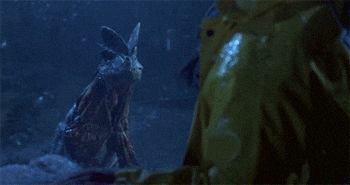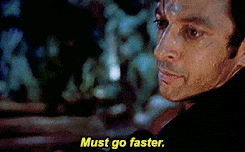Last Updated on January 22, 2023
Dinosaurs are, in case you weren’t already aware, freaking awesome. Huge, murderous lizards rampaging through jungles and ill-conceived amusement parks? Yes please.
Dinosaurs actually have a long-standing pedigree as part of Dungeons & Dragons, and their presence in monster manuals dates all the way back to the very earliest editions of the game.
Despite the fact that dinosaurs have been a part of D&D just as long as goblins, rust monsters, gelatinous cubes, and the eponymous dragon, I rarely see them used in 5e. This is a shame.
So, part one of the manifesto espoused in today’s guide is this: your campaign needs more dinosaurs.
Part two of this article seeks to address the reason why I think dinosaurs are an oft-neglected biosphere of the Monster Manual: if you use the 5e RAW to run your dinosaurs, they’re not very interesting.
The Monster Manual contains six wonderful, scaly monstrosities for use in your campaigns, and the Volo’s Guide to Monsters sourcebook adds a further five.
Dinosaurs in the Monster Manual: Allosaurus, Ankylosaurus, Plesiosaurus, Pteranodon, Triceratops, Tyrannosaurus Rex
Dinosaurs in Volo’s Guide to Monsters: Brontosaurus, Deinonychus, Hadrosaurus, Stegosaurus, Velociraptor
That’s 11 types of dinosaurs with an array of challenge ratings (CR) ranging from 1/4 (the Velociraptor) to 8 (The T-Rex, which is the highest of any beast in the monster manual), suited to just about any environment.
Categorizing Dinosaurs
In D&D 5e, dinosaurs are lumped into the more general monster category of beasts.
“Beasts are nonhumanoid creatures that are a natural part of the fantasy ecology. Some of them have magical powers, but most are unintelligent and lack any society or language. Beasts include all variety of ordinary animals, dinosaurs, and giant versions of animals”
– Monster Manual, pg. 6
Now, we recently wrote a great article on beasts in 5e that deals with the finer points of categorizing beasts, wild shape, and spells that interact with this sort of monster.
If you’re looking for a thorough breakdown of the RAW of 5e as they apply to beasts (including dinosaurs), he’s got you covered.
As such, the rest of this article is going to stray a little further off the trail into the uncharted wilderness of homebrewing and opinionated waffle. You have been warned.
A Note on Dinosaur Design
It wouldn’t be an article about dinosaurs if we didn’t do some tampering with the laws of nature.

Generally speaking, as with most beasts, dinosaurs tend toward having lower AC scores thanks to being reliant on natural armor.
This doesn’t mean that, for example, an army of lizard folk couldn’t strap a bunch of spiky metal plates to their pet T-Rex and ride it into battle (is it really that obvious I used to play a lot of Warhammer?), but the average dinosaur encountered in the wild rarely has an AC that’s higher than 14.
Also, for obvious reasons, dinosaurs tend to rely heavily on claw, bite, and sometimes tail attacks and don’t have any access to magical abilities.
Once again, I’m not saying you can’t shove a pack of velociraptors into the Feywild for a few years and then reasonably justify them developing the ability to teleport short distances, but it ultimately depends on just how much psychological trauma you think your players can shrug off in a single session.
This combination of low AC, somewhat-pedestrian attacks, and no resistances to damage types makes dinosaurs, taken at face value, pretty good candidates for lower-level encounters.
However, this also means they run the risk of committing the cardinal sin of 5e monster design: being a big bag of hit points with multi-attack.
Sure, some dinosaurs can fly, swim, or hunt in packs, and the Allosaurus has a cool Pounce attack. But, for the most part, the burden of making these monsters as awesome as they should be falls largely to the DM.
What we’re going to do, then, is take a few of the dinosaurs from the Monster Manual, steal some ideas from Matt Colville’s video on action-oriented monsters, and combine them with my own designs.
Hopefully what we end up with is the kind of scaly (or feathered, if you’re a pedant) nightmare fuel that dinosaurs deserve to be.
In practice, this basically involves giving each dinosaur a small suite of legendary actions which should help make them not only more suited to fighting a party of PCs one-on-many but also make dinosaurs feel like more of a flavorful threat than your average carnivorous beast.
I’ve chosen four of the more iconic dinosaurs in the Monster Manual and Volo’s Guide for this treatment as well as made up stats and abilities for the Dilophosaurus because it’s not only my favorite dinosaur, but I think that fighting one would make for a really cool, scary encounter.
Allosaurus
Source: Basic Rules
Described in an old BBC documentary I watched as a kid as “the lion of the Jurassic,” the Allosaurus is a great jumping off point for thinking about interesting dinosaur design.
The Allosaurus is size large, and its basic stat block comes with a cool Pounce ability baked in.
This means we’ve essentially got an ambush predator that’s still beefy enough to wade into a stand-up fight. Let’s take a look at the base stats.
So, to emphasize the idea that this dinosaur hunts like a lion, tiger, or other big cat, let’s work up a few extra abilities.
Actions
Ambusher:
While heavily or lightly obscured by dense foliage or vegetation, the Allosaurus can use its bonus action to hide. When attacking from hidden, the Allosaurus’ bite action inflicts an additional 2d10 piercing damage.
Serrated Teeth:
The Allosaurus’ tagged teeth are ideally suited to crippling its prey, making escape impossible.
If the Allosaurus makes a successful opportunity attack against a creature, that creature’s speed is halved until the end of the Allosaurus’ next turn.
Dilophosaurus
Source: Black Citadel RPG
Why this awesome, acid-spitting dinosaur isn’t in the Monster Manual is frankly beyond me. For the base stats, we’re going to be using the Velociraptor (see below) but adding in some additional nasty abilities.
Actions
Spit Venom (range: 10 feet):
The Dilophosaurus extends its frills and spits poison into its victim’s face. The target must make a Dexterity saving throw (DC 14), taking 3d6 acid damage and becoming Poisoned and Blinded on a failed save.
On a successful saving throw, the target takes half damage and is not Poisoned or Blinded. The target may make a DC 10 Constitution saving throw at the start of each of its turns in order to end the effect.
Reactions
Frill Display:
When a creature within 5 feet of the Dilophosaurus makes a melee attack against the creature, the Dilophosaurus can use its reaction to expand its colorful frills, imposing disadvantage on the attack roll.
If the attack misses, the Dilophosaurus may then move up to half its speed. This movement does not provoke opportunity attacks.

Pteranodon
Source: Basic Rules
Ever since Jurassic Park 3, I’ve found flying dinosaurs to be legitimately terrifying. This take on the sharp-beaked, bat-winged Pteranodon hopefully delivers on that experience a little better than the creature’s basic stats.
Actions
Up and Down:
On its turn, one creature hit by the Pteranodon’s bit attack is grappled. The Pteranodon can then use its bonus action to lift a small or medium creature vertically by up to half its flying speed.
Two Pteranodons grappling the same small or medium sized creature can lift it up to a distance equal to their flying speed.
Large creatures require four Pteranodons working together to lift them off the ground and cannot be lifted more than half of the Pteranodons’ flying speed per round.
Tyrannosaurus Rex
Source: Basic Rules
The ultimate carnivore, the king of the Cretacious, death on two legs with teeny tiny arms.
Unfortunately, while it boasts a daunting CR of 8, the T-Rex found in the Monster Manual is… kind of underwhelming.
Sure, it has multi-attack and its bite can grapple, but there’s little else that makes fighting the most fearsome dinosaur of all time feel like more than a slog through waist-high wallpaper paste.
It’s dull – a dragon without a breath attack. Hopefully, these additional actions serve to make fighting a T-Rex feel more like the perilous boss fight it should.
Senses
Based on Movement:
If the T-Rex wishes to make an attack against a target that has moved 0 feet and taken no action since the end of the T-Rex’s last turn, the T-Rex must succeed on a DC 16 Wisdom check.
If it fails the check, the attack is wasted. If it succeeds, it makes the attack at disadvantage.
Actions
Bite (modified):
When the T-Rex grapples a creature after using its bite attack, it can use its bonus action to throw the creature up to 30 feet.
If the thrown creature impacts a solid object, it takes 4d8 + 4 bludgeoning damage and is knocked prone.
If the thrown target impacts another creature, the damage is divided equally between them, and both creatures are knocked prone.
Tail (modified):
All creatures within 10 feet of the T-Rex must succeed on a DC 10 Dexterity saving throw or take 3d8 + 7 bludgeoning damage and be knocked prone.
Primal Roar:
The T-Rex emits a bloodcurdling roar, forcing all creatures that can see and hear it to succeed on a DC 14 Wisdom saving throw or become Frightened.
Any creature affected can repeat the saving throw at the end of its turn. Any creature who succeeds on this saving throw is immune to the effects of the T-Rex’s roar for 24 hours.
Legendary Actions:
At the end of another creature’s turn, the T-Rex may take one of the following Legendary Actions. These actions (with the exception of Gulp) recharge on Initiative count 20.
- Charge: The T-Rex moves up to its speed towards a creature and makes a Bite attack.
- Stomp: The T-Rex stamps its clawed foot against the ground, forcing all creatures within 30 feet to make a Constitution saving throw or have their speed halved until the end of their next turn.
- Gulp! (recharge 5-6): The T-Rex makes a bite attack against a creature. On a hit, if the creature has fewer than 5d8 hit points (roll each time), it is instantly devoured.

Velociraptor
Source: Volo’s Guide to Monsters
Probably among the most iconic movie monsters of all time, Velociraptors in the 5e rules fall woefully short of that kind of intelligent ambush hunter.
So let’s try and make them into more of a blood-chilling killing machine and less of a 6-foot turkey.
Stats: Change the Velociraptor’s Intelligence to 12 (+1)
Actions
Ambush:
On initiative 20 of the first round of combat, all Velociraptors move up to their speed, allowing them to surround and outmaneuver even the most well-prepared hunters.
Clever Girl:
The velociraptor makes itself a visible threat, forcing all creatures within eyesight to make a DC 14 Wisdom saving throw.
Creatures who fail this saving throw treat all other Velociraptors within eyeshot that are lightly or heavily obscured as Invisible unless they attack.
Open Doors:
Velociraptors can open doors because of course they can. If you want to be kind of silly about this, give each Velociraptor the ability to innately cast Knock once per day.
Pounce:
If the Velociraptor moves at least 30 feet straight toward a creature and then hits it with a claw attack on the same turn, that target must succeed on a DC 10 Strength saving throw or be knocked prone.
If the target is prone, the Velocirapto can make one bite attack against it as a bonus action.
And that’s it. Hopefully, these little changes and extra abilities will help make dinosaurs in your campaign feel as dangerous as nature intended.
Happy adventuring. And remember: life, uh, finds a way.

I played my first tabletop RPG (Pathfinder 1e, specifically) in college. I rocked up late to the first session with an unread rulebook and a human bard called Nick Jugger. It was a rocky start but I had a blast and now, the better part of a decade later, I play, write, and write about tabletop RPGs (mostly 5e, but also PBtA, Forged in the Dark and OSR) games for a living, which is wild.
